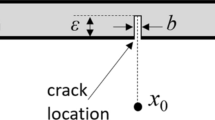Abstract
In order to solve the problem of structural damage identification, this paper proposes a damage identification method, called ASS, based on a single-node mode shape parameter. The method, which combines the mode shape parameter and the additional mass methods, can accurately identify the structural damage position and the damage parameter. Moreover, the best accuracy is achieved when an additional mass of approximately 5% of the total mass of the beam is used near the fixed hinge support. In the proposed identification method, only the single-node mode shape parameter of the beam structure is required to judge the position of the damage. This can lead to its straightforward adoption in practical engineering situations requiring structural damage detection in beams.







Similar content being viewed by others
Data availability
Not applicable.
Code availability
Not applicable.
References
Doebling SW, Farrar CR, Prime MB (1998) A summary review of vibration-based damage identification methods. Shock Vibr Dig 30(2):91–105
QiuWei Y (2008) Two-stage approach for structural damage diagnosis using incomplete modal parameters. J Mech Strength 30(4):555–558
Xin S (2014) Study on bridge damage identification based on dynamic detection [D]. Chang’an University
Pandey AK, Biswas M (1994) Damage detection in structures using changes in flexibility. J Sound Vib 169(1):3–17
Lee YS, Chung MJ (2000) A study on crack detection using eigenfrequency test data. Comput Struct 77(3):327–342
Pandey AK, Biswas M, Samman MM (1991) Damage detection from changes in curvature mode shapes. J Sound Vib 145(2):321–332
Songtao X, Yuyin Q, Rong C et al (2003) Damage identification and experiments of frame structure base on second-order frequency sensitivity. J Tongji Univ 31(3):263–267
Xiaochao C, Qibo M (2014) Damage detection for cracked beams by using auxiliary mass approach combined with fractal dimension method. Noise Vib Control 34(3):25–30
Zhisong W, Huiyong G, Zhengliang L (2008) Identification methods for different structural damage based on frequency response. Eng Mech 6:146–151
Zhong S, Oyadiji SO (2008) Identification of cracks in beams with auxiliary mass spatial probing by stationary wavelet transform. J Vib Acoust 130(4):1257–1261
Xuesong L, Hongwei M, Yizhou L (2019) Structural damage identification based on convolution neural network. J Vib Shock 38(01):167–175
Dongbing Z, Xianglin J, Guoliang Z (2012) Study on influence of the truss bridge’s nature frequency by added massed. J Wuhan Univ Technol 34(3):97–100
Shuiping F (2007) Study of bridge damage diagnosis based on modal analysis theory. Nanchang University
Nobukawa S, Nishimura H, Yamanishi T (2019) Pattern classification by spiking neural networks combining self-organized and reward-related spike-timing-dependent plasticity. J Artif Intell Soft Comput Res 4:283–291
Lee J, Kramer BM (1993) Analysis of machine degradation using a neural network based pattern discrimination model. J Manuf Syst 12(5):379–387
Mask G, Wu X, Ling K An improved model for gas-liquid flow pattern prediction based on machine learning. J Pet Sci Eng 183:106370
Ying W, Yong F, Priyanka B, Christos D (2010) High-dimensional pattern regression using machine learning: from medical images to continuous clinical variables. NeuroImage 50(4):1519–1535
Thach NN, Ngo DB-T, Xuan-Canh P, Hong-Thi N, Thi BH, Nhat-Duc H, Dieu TB (2018) Spatial pattern assessment of tropical forest fire danger at Thuan Chau area (Vietnam) using GIS-based advanced machine learning algorithms: a comparative study. Ecol Inform 46:74–85
Zanoni M, Fontana FA, Stella F (2015) On applying machine learning techniques for design pattern detection. J Syst Softw 103:102–117
Tran NM, Burdejová P, Ospienko M, Härdle WK (2019) Principal component analysis in an asymmetric norm. J Multivar Anal 171:1–21
McKeown MJ, Hansen LK, Sejnowsk TJ (2003) Independent component analysis of functional MRI: what is signal and what is noise? Curr Opin Neurobiol 13(5):620–629
Vigário R, Särelä J, Jousmäki V, Hämäläinen M, Oja E (2000) Independent component approach to the analysis of EEG and MEG recordings. IEEE Trans Biomed Eng 47(5):589–593
Safavi H, Correa N, Xiong W, Roy A, Adali T, Korostyshevskiy VR, Whisnant CC, Seillier-Moiseiwitsch F (2008) Independent component analysis of 2-D electrophoresis gels. Electrophor 29(19):4017–4026
Ekezie DD (2013) Principal component analysis, an aid to interpretation of data. A case study of oil palm (Elaeis guineensis Jacq.). J Emerg Trends Eng Appl Sci 4(2):237–241
Ma QL, Yan A, Hu Z, Li Z, Fan B (2000) Principal component analysis and artificial neural networks applied to the classification of Chinese pottery of neolithic age. Anal Chim Acta 406(2):247–256
Almeida MR, Logrado LPL, Zacca JJ, Correa DN, Poppi RJ (2017) Raman hyperspectral imaging in conjunction with independent component analysis as a forensic tool for explosive analysis: the case of an ATM explosion. Talanta 174:628–632
Ludwig A, Pustal B, Herlach DM (2001) General concept for a stability analysis of a planar interface under rapid solidification conditions in multi-component alloy systems. Mater Sci Eng A 304:277–280
Dutta RK, Roijers RB, Mutsaers PHA, de Goeij JJM, van der Vusse GJ (2005) Principal component analysis of elements in atherosclerotic human coronary arteries. Nucl Instrum Methods Phys Res B 231(1-4):245–250
Funding
This work was supported by Shaanxi Institute of Technology project (Gfy23-23).
Author information
Authors and Affiliations
Corresponding author
Ethics declarations
Ethics approval
Not applicable.
Consent to participate
The authors claim that none of the contents in this manuscript has been published or considered for publication elsewhere.
Consent for publication
Not applicable.
Competing interests
The authors declare no competing interests.
Additional information
Publisher’s Note
Springer Nature remains neutral with regard to jurisdictional claims in published maps and institutional affiliations.
Rights and permissions
Springer Nature or its licensor (e.g. a society or other partner) holds exclusive rights to this article under a publishing agreement with the author(s) or other rightsholder(s); author self-archiving of the accepted manuscript version of this article is solely governed by the terms of such publishing agreement and applicable law.
About this article
Cite this article
Sun, H., Du, Z. Proposing a novel structural damage indicator for beams: integrating single-node mode shape parameters and additional mass methods. Int J Adv Manuf Technol (2024). https://doi.org/10.1007/s00170-023-12893-x
Received:
Accepted:
Published:
DOI: https://doi.org/10.1007/s00170-023-12893-x




